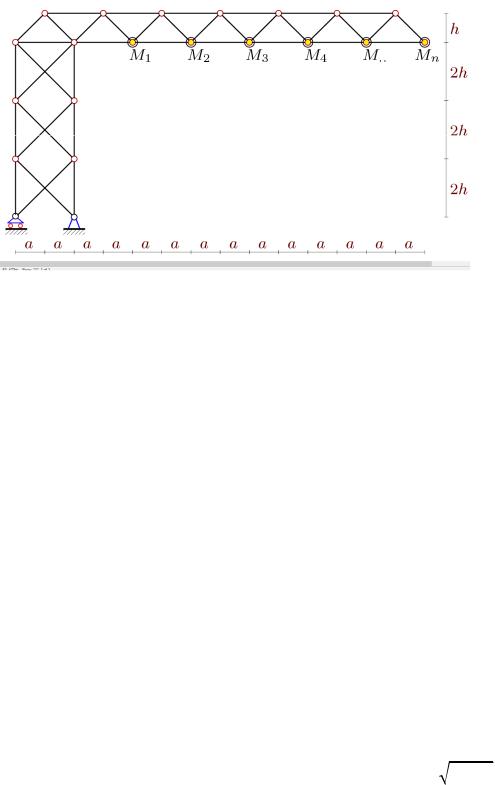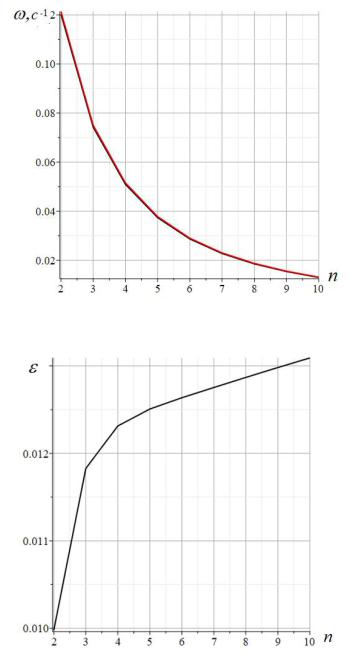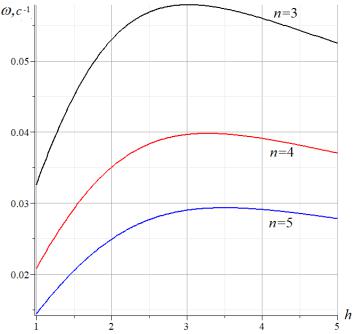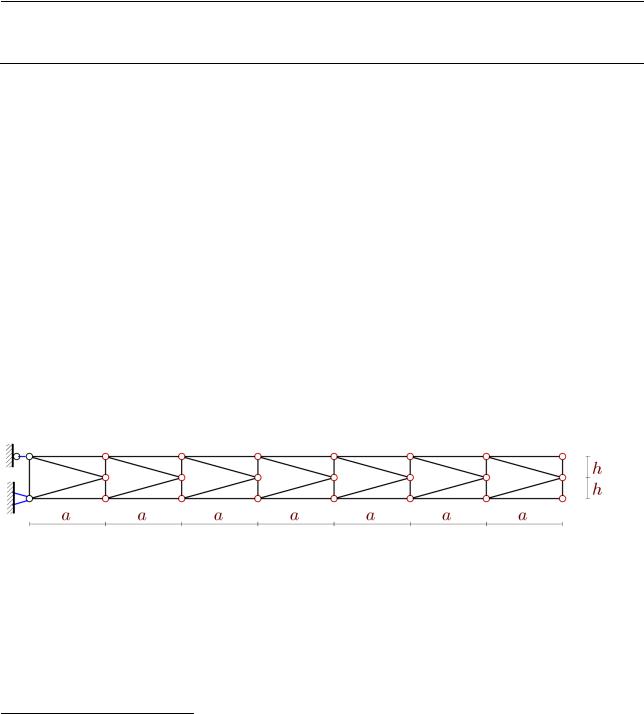
Строительная механика и конструкции. Прикладные задачи механики деформируемого твердого тела. Сафронов В.С., Козлов А.В
.pdf(регулярной) структуре. Опасность изменяемости, пусть даже эта изменяемость мгновенная, очевидна. Коварство же состоит в том, что имея некоторое готовое решение для фермы с определенным числом панелей, проектировщик может, не задумываясь, изменить число панелей, рассчитывая, что и результаты изменятся несильно. Трудно представить, что результат как-то заметно изменится, если вместо 30 панелей рассмотреть ферму с 31 панелью. Но, как показывает приведенный анализ, эти две фермы могут отличаться принципиально. Одна ферма будет изменяема другая — нет. Конечно, и изменяемая ферма с "заваренными" шарнирами будет работать. Можно рассчитать ее как статически неопределимую. Однако практический инженер никогда не поставит в производство ферму, держащуюся только на сварке узлов. Все преимущество ферм состоит именно из того, что элементы в конструкции работают только на сжатие и растяжение.
Здесь рассмотрены некоторые внешние, геометрические признаки изменяемости плоских стержневых систем. Кроме признаков, для проверки изменяемости есть также методы проверки: метод нулевых нагрузок, метод отделения узлов, соединенных с фермой двумя стержнями и др. Ферма 11, для которой еще не найден геометрический критерий изменяемости, показывает, что работа в выбранном направлении анализа стержневых структур может быть продолжена.
Исследование выполнено при поддержке Междисциплинарной научнообразовательной школы Московского университета «Фундаментальные и прикладные исследования космоса».
Библиографический список
1.Осадченко Н.В. Расчёт прогиба плоской неразрезной статически определимой фермы с двумя пролётами // Постулат. 2017. № 12(26). С. 28.
2.Кирсанов М.Н. Плоские фермы. Схемы и расчетные формулы: справочник. М.: ИНФРА-М, 2019. 238 с.
3.Kirsanov M.N. Trussed Frames and Arches: Schemes and Formulas. Cambridge Scholars Publishing, 2020. 178 p.
4.Хазанов Х.С. Алгоритм выбора метода исследования геометрической неизменяемости и определения усилий в стержнях ферм; Куйбышевский авиационный институт. Куйбышев, 1984. 32 с.
5.Структурно-параметрическая оптимизация стержневых металлических конструкций на основе эволюционного моделирования / И.Н. Серпик, А.В. Алексейцев, Ф.Н. Левкович, А.И. Тютюнников // Изв. вузов. Сер. Строительство. 2005. №8. С. 16-24.
6.Алексейцев А.В. Оптимальный структурно-параметрический синтез систем усиления металлических ферм // Строительная механика инженерных конструкций и сооружений. 2014. №. 2. С. 37-46.
7.Маркосян Г.Х. Выполнение кинематического анализа и расчёт плоских ферм в интерактивной форме // Смотр-конкурс научных, конструкторских и технологических работ студентов Волгоградского государственного технического университета. Волгоград, 2017. С. 142–143.
8.Лисовенко Д.В., Доронина Е.Р. Исследование геометрической неизменяемости
плоских стержневых систем // Современные технологии в промышленном производстве: материалы и программа III Всеукраинской межвуз. науч.-техн. конф.:
в2-х ч. Сумы: СумДУ, 2014. Ч.1. С. 186.
9.Рабинович И.М. Курс строительной механики стержневых систем. Ч. 1. Статически определимые системы. 2-е изд. М.-Л.: Стройиздат, 1950. 388 с.
10.Мюллер-Бреслау Г. Графическая статика сооружений. 2-е изд. СПб.: К. Л. Риккер, 1908. Т. 1. 505 с.
11.https://www.wolframalpha.com/
30

References
1.Osadchenko N.V. Calculation of the deflection of a flat continuous statically definable truss with two spans. Postulate. 2017. №. 12 (26). 28.
2.Kirsanov M.N. Planar trusses. Schemes and formulas: a handbook. Moscow: INFRA-M, 2019. 238 p.
3.Kirsanov M. N. Trussed Frames and Arches: Schemes and Formulas. Cambridge Scholars Publishing, 2020.178 p.
4.Khazanov Kh.S. Algorithm for choosing a method for studying geometric immutability and determining forces in truss rods. Kuibyshev Aviation Institute. Kuibyshev 1984.32 p.
5.Serpik I.N., Alekseytsev A.V., Levkovich, F.N., Tyutyunnikov, A.I. Structural-parametric optimization of rod metal structures based on evolutionary modeling. Izvestiya vysshikh educational institutions. Construction. 2005 (8). Pp. 16–24.
6.Alekseytsev A.V. Optimal structural-parametric synthesis of reinforcement systems for metal trusses. Structural mechanics of engineering structures and structures. 2014. No. 2. Pp. 37–46.
7.Markosyan G.Kh. Implementation of kinematic analysis and calculation of flat trusses in an interactive form. Review-competition of scientific, design and technological works of students of Volgograd State Technical University. 2017. Pp. 142–143.
8.Lisovenko D.V., Doronina E.R. Study of geometric immutability of plane rod systems: Modern technologies in industrial production: materials and program of the III AllUkrainian interuniversity. scientific and technical conf .: in 2 p.Sumy State University, 2014.
9.Rabinovich I.M. A course in structural mechanics of rod systems. 2nd ed. Part 1. Statically determinate systems. Moscow-Leningrad . Stroyizdat, 1950. 388 p.
10.Müller-Breslau G. Graphic statics of structures. 2nd ed. T. 1. SPb .: K.L. Rikker, 1908.505 p.
11.https://www.wolframalpha.com/
SIGNS OF GEOMETRIC VARIABILITY OF REGULAR TRUSSES
M. N. Kirsanov
National Research University«MPEI»
Russia, Moscow
Doctor of Physical and Mathematical Sciences, Professor of the Department of Robotics, Mechanotronics, Dynamics and Strength of Machines, tel.: +7(495)362-73-14; e-mail: c216@ya.ru
The features of the structure of planar statically determinate regular (periodic) trusses that allow instantaneous geometric variability at a certain value of the number of panels are considered. A sufficient criterion of variability is proposed, extending the well-known criterion of I. M. Rabinovich. The formulation of both criteria is given in terms of graph theory. The proof of the proposed criterion, based on the existence of an open chain of rods of a certain type in the truss lattice, is given by static methods. Examples of ten trusses and corresponding patterns of the distribution of virtual speeds of nodes in cases of design variability are given. To identify the kinematics of such trusses, an algorithm is used for step-by-step calculation of the velocities of the nodes of the variable truss using the method for determining the velocity of the middle node of a hinged rod two-link link according to the velocities of its ends. A system of four kinematic equations of the algorithm implemented as a subroutine is written.
Keywords: truss, Maple, variabilitycriterion, truss structure analysis, forces calculation, graph theory
31

УДК 624.04:531.391.3
ANALYTICAL DEPENDENCE OF THE LOWER BOUND OF THE NATURAL OSCILLATION FREQUENCIES OF THE MANIPULATOR TRUSS FROM THE NUMBER OF PANELS
M. N. Kirsanov1, Sun Jiaxuan2
National research University«MPEI»
Russia, Moscow
1Doctor of Physical and Mathematical Sciences, Professor of the Department of Robotics, Mechanotronics, Dynamics and Strength of Machines, tel.: +7(495)362-73-14, e-mail: c216@ya.ru
2Student, tel.: +79852244660, e-mail: laogejiangdaoli@gmail.com
An analytical estimation of the fundamental frequency of oscillations of a planar statically determinate model of a manipulator with an arbitrary number of panels in the console part and rack is derived by the method of induction using two parameters with the involvement of operators of the Maple computer mathematics system. The mass is allocated to the nodes of the lower belt of the console. To output the formula, the operators of the specialized LinearAlgebra and genfunc packages are used. The coefficients in the desired formula are found as solutions of recurrent equations composed according to a series of solutions for trusses with a consistently increasing number of panels. Compared to similar solutions for planar regular trusses that use Dunkerley estimation, the solution is distinguished by its high accuracy. Numerical analysis of the truss oscillation spectrum, taking into account many degrees of freedom, shows that the error of the obtained analytical estimate does not exceed 2% on average .
Key words: truss, console, method of Dunkerley, the oscillations of lower frequency, induction, Мaple.
Introduction
The calculation of manipulators designed for high-speed work involves the analysis of natural oscillation 1frequencies. One of the most significant dynamic characteristics of a structure is its first (lowest) natural frequency. If the structure contains a large number of elements (rods), the complete calculation of a system with many degrees of freedom (based on the number of nodes endowed with masses) is a complex numerical problem. The development of modern systems of symbolic mathematics makes it possible to use analytical methods along with numerical methods. The value of such solutions is determined by both accuracy and versatility. An analytical solution in the form of a formula obtained for a single structure with parametrically specified dimensions and loads has significantly less value than a solution that takes into account the number of elements. For regular structures with periodically repeated elements, it is possible to take into account their number in the final calculation formula using the induction method [1]. In this paper, we consider a planar, statically determinate model of the truss of a cantilever manipulator with a mass distributed over the nodes of the lower belt of the console. The solution is based on the method used earlier in the problems of analyzing the static deflection of trusses [1]. The frequencies of beam truss oscillation were studied analytically in [2–10].
Solution
The truss post (Fig. 1) with two supports has m cross-shaped panels in height. The console contains n panels with a triangular grid. In total, there are 4 m n 6 rods in the truss,
counting three rods that model movable and fixed supports. Ignoring the horizontal displacements, we consider only the vertical oscillations of the loads in the nodes of the structure. The number of degrees of freedom of such a model is equal to the number of loads N = n. The truss diagram has a
© Kirsanov M. N., Jiaxuan Sun, 2021
32

regular type with two parameters n and m. The stress state of the truss rods can be calculated analytically using the program in the Maple system [1, 4–7] . The program includes a method for cutting out nodes.
Fig. 1. The scheme of the manipulator, m=2, n=5
The equations of mass oscillations have the form:
|
|
|
|
|
|
|
|
|
|
(1) |
|
|
|
|
|
JNY DNY 0, |
|||||
where D |
N |
is the |
stiffness matrix, Y [y ,y |
2 |
,...y |
N |
]T |
is the vector of vertical displacements |
of |
|
|
|
1 |
|
|
|
|
||||
loads. If all the masses are equal M1 M2 |
... Mn M , then JN M IN – is the diagonal inertia |
|||||||||
matrix, IN |
|
|
|
|
|
|
|
|
|
|
– the unit matrix, Y – the acceleration vector of nodes with masses. The inverse of the |
||||||||||
stiffness matrix DN is the matrix BN , whose elements are calculated using the Mohr's integral: |
|
|||||||||
|
|
|
|
3 |
|
|
|
|
||
|
|
|
bi, j |
Sk(i)Sk( j)lk |
/(EF). |
(2) |
||||
|
|
|
|
k 1 |
|
|
|
|
||
Here, Sk(i) |
is the force in the rod k |
from the action of a single vertical force at the node i, lk |
||||||||
is the length of the rod k, E is the elastic modulus of the rod material, F is the cross-sectional area of the rods. The stiffness of the rods is assumed to be the same. The three support rods are not deformed. The forces in these rods are not included in the sum (2).
The approximate solution according to the Dunkerley method [8] for the lower estimate of the first oscillation frequency D is expressed in terms of the oscillation frequencies of individual loads in the marked nodes:
2 |
N |
|
|
2 |
, |
(3) |
|
D |
k |
k 1
where k is the partial oscillation frequency of the mass M located in the console node on the lower belt. In the case of oscillations of one mass, equation (1) has the form: M yk dk yk 0, where dk is the coefficient of rigidity, yk is the displacement of the mass, and yk is the acceleration. Hence, the oscillation frequency of a single load (partial frequency) has the form: k 
 dk /M . The
dk /M . The
|
|
3 |
|
stiffness coefficient is calculated using the Mohr integral: k |
1/dk |
S(jk) 2 |
lj /(EF). Here it |
|
|
j 1 |
|
33

is indicated: S(jk) – the forces in the rod with the number j from the action of a single vertical force applied to the node where the mass with the number k is located . From(3) follows:
|
|
|
|
|
N |
|
|
|
|
|
|
|
D2 |
M k M n. |
(4) |
||||||
|
|
|
|
|
k 1 |
|
|
|
|
|
General view of the solution for the n coefficient at m = 3: |
|
|||||||||
|
n |
(C |
|
a3 |
C |
2,n |
c3 C |
3,n |
h3)/(h2EF) |
(5) |
|
1,n |
|
|
|
|
|
||||
Solving the problem sequentially for n = 1, 2, 3, ..., we get:
|
2(15h3 6a3 2c3)/(h2EF), |
|
2 |
4(27h3 20a3 4c3)/(h2EF), |
|
1 |
2 129h3 |
140a3 20c3 / h2EF , |
|
8 63h3 90a3 10c3 / h2EF , |
|
3 |
4 |
||||
5 |
10 87h3 |
90a3 14c3 / h2EF , |
6 |
4 345h3 728a3 56c3 / h2EF ,... |
|
Using the rgf_findrecur operator from the special genfunc package of the Maple system, you can get recurrent equations for sequence elements. For the coefficient C1 , we have a fifth-order
linear equation: C1,n 5C1,n 1 10C1,n 2 10C1,n 3 5C1,n 4 C1,n 5 .
The rsolve operator gives a solution to this equation:
C |
|
(4n4 14n3 14n2 |
4n)/3. |
(6) |
1,n |
|
|
|
|
Other coefficients are found in the same way: |
|
|
||
C2,n 4n3 |
12n2 14n, C3,n (2n3 4n2 4n)/3. |
(7) |
||
To generalize the solution to an arbitrary number, you need to repeat the entire solution sequentially for different m = 1, 2, .. Calculations show that only the coefficient C2 depends on the
number of panels m vertically, and then linearly. Thus, we have the values of the coefficients in the general case
C1 2n(2n 1)(n 2)(n 1)/3, C2 2m(n 1)(2n2 4n 3)/3, C3 2n(n 1)(n 2)/3. Hence, taking into account (4) and (5), we obtain the final formula for the lower bound of
the first natural frequency ofoscillation of the truss:
D h |
3EF |
|
2M(n 1)(n(n 2)((2n 1)a3 c3) m(2n2 4n 3)h3) . |
(8) |
Analysis of the obtained results
The accuracy of analytical solutions (4) factors (6, 7) can be estimated from a comparison with the solution of the problem of oscillation of a system with many degrees of freedom, N, obtained numerically. To find the eigenvalues of a matrix BN , we use the Eigenvalues operator from the LinearAlgebra package of the Maple system. The graph (Fig. 2) shows the curves of the dependence of the first frequency num obtained numerically and D according to the formula (4). The curves are almost identical. Accepted: EF 1000Н , M = 100kg, a = 3m, h = 4m. Accuracy (relative error ) num D / num depends on the number of panels (fig. 3).
The resulting formula can be used to estimate the frequency of oscillation of the truss with a very large number of rods. As you know, the accuracy of the numerical calculation decreases with an increase in the number of structural elements, while the analytical solution has an almost
34

constant and high accuracy. This can be seen from the curve in Figure 3, which goes to the horizontal asymptote.
Fig. 2. Frequency dependence on the number of panels
Fig. 3. The error of Dunkerley's estimation depending on number of panels
The error of the solution varies depending on the number of panels from 1%, for n = 2, to 1.3% for a large number of panels. For comparison, we note that in [11] in the problem of vibrations of the nodes of a beam truss with a triangular lattice and with two panels, the solution according to the Dunkerley method gives an error of 29%.
The oscillation frequency depends non-linearly on the height of the panel h (Fig. 4). The graphs are constructed according to the analytical solution (8) at m =7 and the same values of mass and stiffness as the previous graphs. As the number of n panels in the console increases, the maximum frequency value shifts to the right on the graph.
35

Fig. 4. Dependence of the oscillation frequency on the height of the truss
Another method for obtaining an analytical estimate of the lowest frequency is based on the Rayleigh method [11]. This method gives even greater accuracy and estimates the frequency from above, but the resulting formula is too cumbersome.
Conclusion
The method of estimating the first frequency by Dunkerley is known, but it is rarely used in practice, since its accuracy is low and in the case of complex systems with many degrees of freedom it involves numerical counting. The development of computer mathematics systems and the method of induction used in the derivation of analytical dependencies for regular systems allowed us to obtain a number of analytical solutions, in particular for the problem of the truss oscillation. The proposed solution turned out to have high accuracy and a very compact shape. The authors still do not know what caused such a high accuracy — whether the choice of the design model, the neglect of horizontal oscillations, or something else. In any case, the formula is quite convenient for use in practice, and the proposed algorithm can be used in solving other similar problems for statically determinate systems.
The investigation was carried out within the framework of the project “Dynamics of light rod structures of manipulators” with the support of a grant from NRU "MPEI" for implementation of scientific research programs "Energy", "Electronics, Radio Engineering and IT", and “Industry 4.0, Technologies for Industry and Robotics in 2020-2022”.
Библиографический список
1.Kirsanov M.N. Trussed Frames and Arches: Schemes and Formulas. Cambridge Scholars Publishing UK, 2020.
2.Воробьев О.В. О методах получения аналитического решения для проблемы собственных частот шарнирных конструкций // Строительная механика и конструкции. 2020. № 1 (24). С. 25–38.
3.Vorobev O. Bilateral analytical estimation of first frequency of a plane truss // Construction
36
of Unique Buildings and Structures. 2020. Vol. 92. Article No 9204 (doi: 10.18720/CUBS.92.4).
4.Кирсанов М.Н., Тиньков Д.В. Аналитические выражения частот малых колебаний балочной фермы с произвольным числом панелей // Строительная механика и конструкции. 2019. № 1(20). С. 14-20.
5.Тиньков Д.В. Аналитические решения задач о собственных частотах колебаний регулярных стержневых систем: дис. ... канд. техн. наук: 01.02.01. Москва, 2019. 113 с.
6.Кирсанов М.Н., Тиньков Д.В. Анализ собственных частот колебаний плоской фермы с произвольным числом панелей // Вестник МГСУ. 2019. Т.14. № 3(126). С. 284–292.
7.Петриченко Е.А. Нижняя граница частоты собственных колебаний фермы Финка // Строительная механика и конструкции. 2020. №3 (26). С. 21-29.
8.Ахмедова Е.Р., Канатова М.И. Собственные частоты колебаний плоской балочной фермы регулярной структуры // Наука и образование в XXI веке: сб. науч. тр. по материалам Междунар. науч.-практ. конф.. Тамбов: ООО «Консалтинговая компания Юком», 2014. С. 17–18.
9.Заборская Н.В. О зависимости частоты колебаний груза от его местоположения на ферме // Радиоэлектроника, электротехника и энергетика: тез. докл. XXII Междунар. науч.-техн. конф. студентов и аспирантов: в 3 т. М., 2016. С. 244.
10.Канатова М.И. Частотное уравнение и анализ колебаний плоской балочной фермы // Trends in Applied Mechanics and Mechatronics. М: Инфра-М, 2015. Т. 1. С. 31–34.
11.Яблонский А.А., Норейко С.С. Курс теории колебаний. М.: Высш. шк., 1975.
References
1.Kirsanov M. N. Trussed Frames and Arches: Schemes and Formulas. Cambridge Scholars Publishing. UK. 2020.
2.Vorobyov O. V. On methods for obtaining an analytical solution for the eigenfrequency problem of articulated structures. Construction mechanics and structures. 2020. No. 1 (24). Pp. 25–38.
3.Vorobev O. Bilateral analytical estimation of first frequency of a plane truss. Construction of Unique Buildings and Structures. 2020. Vol. 92. Article No 9204 DOI: 10.18720/CUBS.92.4
4.Kirsanov M. N., Tinkov D. V. Analytical expressions of the frequencies of small vibrations of a beam truss with an arbitrary number of panels. Construction mechanics and structures. 2019. Vol. 1. No. 20. Pp. 14–20.
5.Tinkov D. V. Analytical solutions of problems on natural frequencies of oscillations of regular rod systems: Dis. ... Cand. of technical sciences: 01.02.01.- Moscow, 2019. 113 p.
6.Kirsanov M. N., Tinkov D. V. Analysis of natural vibration frequencies of a flat truss with an arbitrary number of panels. Bulletin of the MSU. 2019. Vol. 14. no. 3(126). 284–292.
7.Petrichenko E. A. Lower bound of the frequency of natural oscillations of the Fink truss. Construction mechanics and structures. 2020. No. 3 (26). Pp. 21–29.
8.Akhmedova E. R., Kanatova M. I. Eigenfrequencies of oscillations of a flat beam truss of a regular structure. Nauka i obrazovanie v XXI veka: sbornik nauchnykh trudov po materia Mezhdunarodnoy nauchno-prakticheskoy konferentsii. Tambov: LLC "Consulting company Ucom", October 31, 2014. Pp. 17–18.
9.Zaborskaya N. V. On the dependence of the frequency of vibrations of the cargo on its location on the truss. In the book: Radioelectronics, Electrical Engineering and Power Engineering. Abstracts of the Twenty-second International Scientific and Technical
37

Conference of Students and Postgraduates: in 3 volumes. 2016. p. 244.
10.Kanatova M. I. Frequency equation and analysis of vibrations of a flat beam truss. Trends in Applied Mechanics and Mechatronics. Moscow: Infra-M. 2015. Vol. 1. Pp. 31–34.
11.Yablonsky A. A., Noreyko S. S. Course of the theory of oscillations. Moscow: Higher School, 1975.
АНАЛИТИЧЕСКАЯ ЗАВИСИМОСТЬ НИЖНЕЙ ГРАНИЦЫ СОБСТВЕННОЙ ЧАСТОТЫ КОЛЕБАНИЙ ФЕРМЫ МАНИПУЛЯТОРА ОТ ЧИСЛА ПАНЕЛЕЙ
М. Н. Кирсанов1, Сунь Цзясюань2
Национальный исследовательский университет «МЭИ» Россия, г. Москва
1Д-р физ.-мат. наук, профессор кафедры робототехники, мехатроники, динамики и прочности машин,
тел.: +7(495)362-73-14; e-mail: c216@ya.ru
2 Студент, тел.: +79852244660; e-mail: laogejiangdaoli@gmail.com
Методом индукции по двум параметрам с привлечением операторов системы компьютерной математики Maple выведена аналитическая оценка основной частоты колебаний плоской статически определимой модели манипулятора с произвольным числом панелей в консоли и стойке. Массой наделены узлы нижнего пояса консоли. Для вывода формулы используются операторы специализированных пакетов LinearAlgebra и genfunc. Коэффициенты в искомой формуле находятся как решения рекуррентных уравнений, составленных по серии решений для ферм с последовательно увеличивающимся числом панелей. По сравнению с аналогичными задачами для плоских регулярных ферм, где используется оценка по Донкерлею, полученное решение отличается высокой точностью. Численный анализ спектра колебаний фермы с учетом многих степеней свободы показывает, что погрешность полученной аналитической оценки в среднем не превышает 2% .
Ключевые слова: ферма, консоль, метод Донкерлея, колебания, нижняя частота, индукция, Мaple
38

УДК 624.04:531.391.3
DEPENDENCE OF THE NATURAL OSCILLATION FREQUENCY
OF THE HALF-TILT CONSOLE ON THE NUMBER OF PANELS
M. N. Kirsanov1, Dai Qiao2
National Research University“MPEI”,
Russia, Moscow
1Doctor of Physical and Mathematical Sciences, Professor of the Department of Robotics, Mechanotronics, Dynamics and Strength of Machines, tel.: +7(495)362-73-14, e-mail: c216@ya.ru
2Sudent, tel: +7(919)990-97-59, e-mail:228441531@qq.com
We consider a planar cantilever truss, the mass of which is distributed over the nodes. The solution of the problem using the induction method is found in the Maple computer mathematics system. To determine the forces in the rods, the method of cutting out the nodes is used. The main frequency of oscillation is determined by the method of Dunkerley. The error of the obtained dependence is compared with the numerical solution of the problem of the oscillation of the cargo system and turns out to be very small, decreasing to 1% with an increase in the number of panels.
Keywords: console, natural oscillation frequency, Maple, induction, number of panels
Statement of the problem
Numerical calculations controlled by some analytical estimates acquire greater reliability, especially in cases where the complexity of the design model may inevitably lead to the accumulation of rounding errors. Obtaining analytical estimates that contain not only loads, dimensions, and properties of materials as problem parameters, but also integer parameters that determine the proportions of the structure, became possible with the use of symbolic mathematics systems and the development of the induction method. This method is used to find formulas for the deflection of some flat trusses [1-4] and the oscillation frequency [5,6]. In this paper, we consider a cantilever truss with masses distributed over the nodes (Fig.1).
Fig. 1. The truss, n 7
Dunkerley's approximation
To derive the required dependence in an analytical form, we will use the approximate lower approximation of Dunkerley [7]. The number of all nodes of the truss (except for the fixed hinge) endowed with mass is equal to N = 3n + 1, the number of rods, including the support rods, K = 6n +
4.Dunkerley's formula is as follows:
©Kirsanov M. N., Qiao Dai, 2021
39
